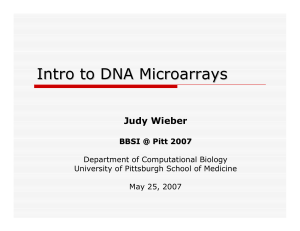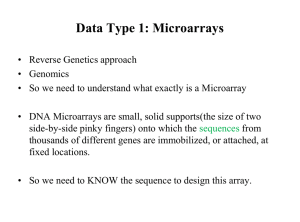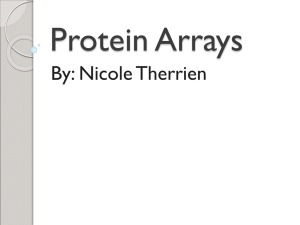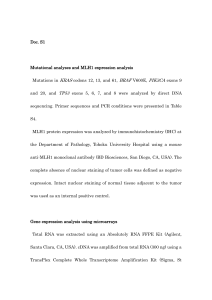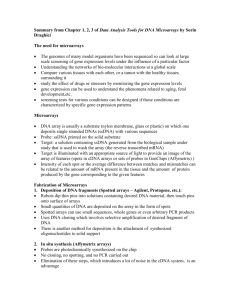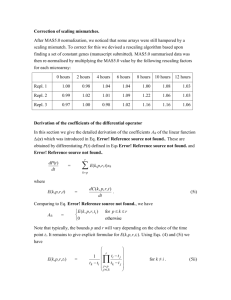Microarray - Clemson University
advertisement
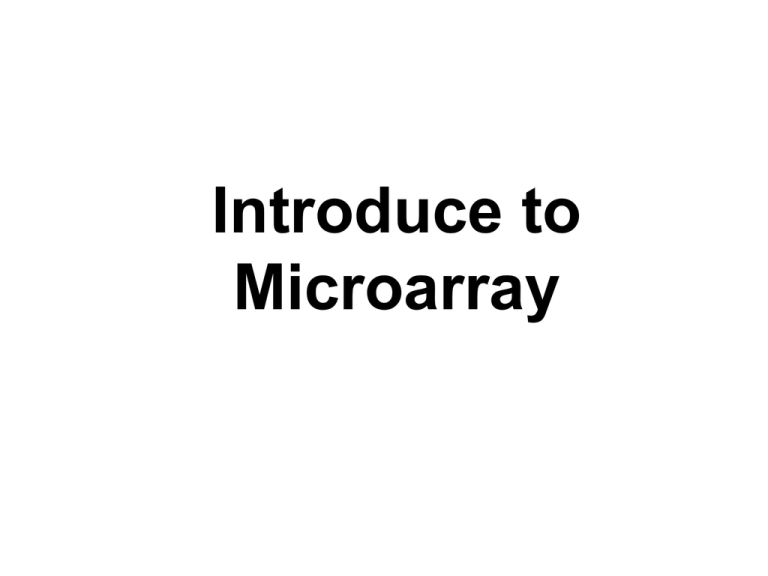
Introduce to Microarray Copyright notice • Many of the images in this power point presentation of other people. The Copyright belong to the original authors. Thanks! Evolution & Industrialization 1989: First Affymetrix Genechip Prototype 1994: First Commercial Affymetrix Genechip 1994- First cDNAs arrays were developed at Stanford University. 1994: First Commercial Scanner-Affymetrix 1996- Commercialization of arrays 1997-Genome-wide Expression Monitoring in S. cerevisiae Why use DNA Microarrays for Expression Analysis? • Conventional expression analysis only allows the study of the expression of a single gene in a single experiment • The highly parallel nature of microarrays allows the simultaneous study of the expression of thousands or even tens of thousands of different genes in a single experiment • Microarrays allow researchers to undertake global expression analysis that is not feasible with conventional techniques What Microarrays detect? • What genes are Present/Absent in a cell? • What genes are Present/Absent in the experiment vs. control? • Which genes have increased/decreased expression in experiment vs. control? • Which genes have biological significance? Why analyze so many genes? • Just because we sequenced a genome doesn’t mean we know anything about the genes. Thousands of genes remain without an assigned function. • Patterns/clusters of expression are more predictive than looking at one or two prognostic markers – can figure out new pathways The 6 steps of a DNA microarray experiment 1. Manufacturing of the microarray 2. Experimental design and choice of reference: what to compare to what? 3. Target preparation (labeling) and hybridization The 6 steps of a microarray experiment (cont.) 4. Image acquisition (scanning) and quantification (signal intensity to numbers) 5. Database building, filtering and normalization 6. Statistical analysis and data mining Different Types of DNA Microarrays How DNA sequences are laid down Spotting Photolithography (Affymetrix) type of DNA sequences cDNA (Complete sequences) Oligonucleotides Affymetrix Microarrays Involves Fluorescently tagged cRNA • One chip per sample • One for control • One for each experiment Spotted Microarrays Involves two dyes/one chip • Red dye • Green dye • Control and experiment on same chip Production of Affymetrix Arrays • Choice of probes – 25mer oligonucleotides – 11-16 per gene – 3’ biased – Dispersed – Chosen to minimize cross-hybridization • Computer algorithms are used to design photolithographic masks for use in manufacturing • • Each gene is represented on the probe array by multiple probe pairs Each probe pair consists of a perfect match and a mismatch oligonucleotide Match and mismatch • • • • The exact match is a section of the mRNA sequence you wish to probe for The mismatch is identical except for one base difference from it’s exact match counterpart, and is used to calculate a background. There are typically 11 “probe pairs” scattered around the chip- called a probe set. By combining the expression values for a probe set, a value for the expression of mRNA can be found. Mismatch probe: Perfect match probe: Target sequence: ATGCTGTACAATCGCTTGATACTGG ATGCTGTACAATAGCTTGATACTGG ATGCTGTACAATAGCTTGATACTGG Why do we have mismatch probes? • Mismatch probes (MM) are trying to detect background. • The mismatch probes are supposed to detect things that are close but not an exact match. • It is assumed that these things also bind to the perfect match (PM), erroneously. Production of Affymetrix Arrays: Photolithographic Synthesis Creating Targets mRNA Reverse Transcriptase cDNA in vitro transcription cRNA Target RNA-DNA Hybridization Targets RNA probe sets DNA (25 base oligonucleotides of known sequence) Non-Hybridized Targets are Washed Away Targets (fluorescently tagged) “probe sets” (oligo’s) Non-bound ones are washed away Custom GeneChips Affymetrix offers over 120 prokaryotic arrays that are manufactured by Nimblegen Inc. Custom GeneChips are also available for both Eukaryotic and Prokaryotic systems. Spotted Arrays • Robotically spotted cDNAs or Oligonucleotides • Printed on Nylon, Plastic or Glass surface – DNA probes prepared in 384-well plates – Glass slides bought commercially or prepared in house • Arrays are spotted with a commercial arrayer • Replicates • Controls Microarray of thousands of genes on a glass slide steel Spotted arrays spotting pin chemically modified slides 384 well source plate 1 nanolitre spots 90-120 um diameter Building the chip Arrayed Library (96 or 384-well plates of bacterial glycerol stocks) Spot as microarray on glass slides PCR amplification Directly from colonies with SP6-T7 primers in 96-well plates Consolidate into 384-well plates Expression profiling with DNA microarrays cDNA “B” Cy3 labeled cDNA “A” Cy5 labeled Laser 1 Hybridization Laser 2 Scanning + Analysis Image Capture Spotted Arrays • • • • Homemade Tailored Cheaper????? Maximum 24,000 features per array • Prone to variability Affymetrix Arrays • • • • Commercially available “Off the rack” More expensive????? Maximum 500,000 features per array • Less variability Oligonucleotide • Greatly reduced cross-hybridization • Uniform Tm • Requires knowledge of gene sequences • More expensive??? cDNA • Cross-hybridization possible • Non-uniform Tm • No gene sequence knowledge required • Less expensive Microarray Experiments Animation •http://www.bio.davidson.edu/courses/genomics/chip/chip.html Biological Question Data Analysis & Modelling Microarray Life Cycle Sample Preparation Microarray Detection Microarray Reaction W.W.W resources • Complete guide to “microarraying” http://cmgm.stanford.edu/pbrown/mguide/ • http://www.microarrays.org – Parts and assembly instructions for printer and scanner; – Protocols for sample prep; – Software; – Forum, etc. • Animation: http://www.bio.davidson.edu/courses/genomics/chip/chip.html
